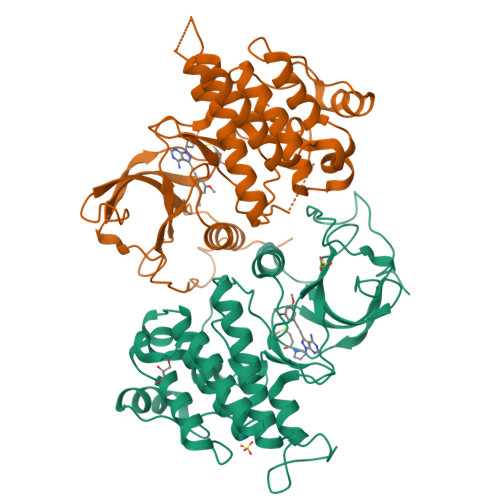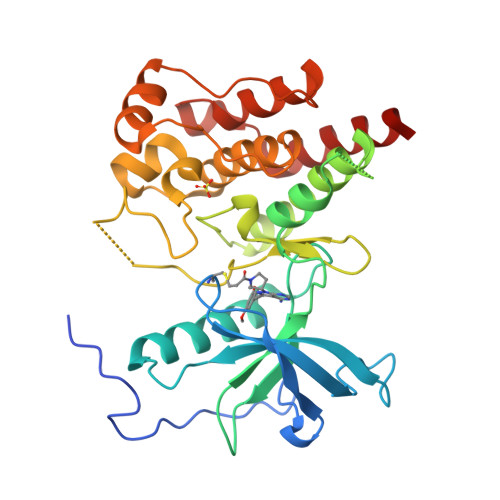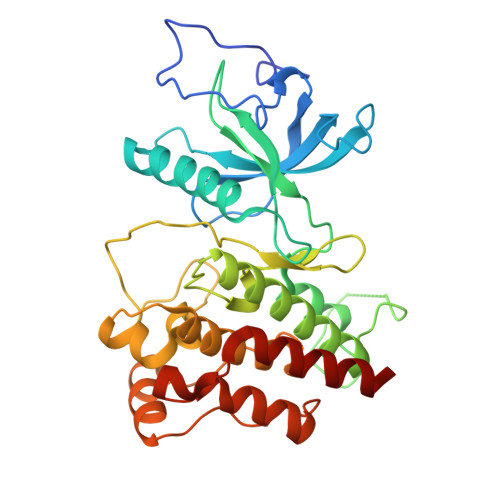A model for decoding resistance in precision oncology: acquired resistance to FGFR inhibitors in cholangiocarcinoma.
Goyal, L., DiToro, D., Facchinetti, F., Martin, E.E., Peng, P., Baiev, I., Iyer, R., Maurer, J., Reyes, S., Zhang, K., Majeed, U., Berchuck, J.E., Chen, C.T., Walmsley, C., Pinto, C., Vasseur, D., Gordan, J.D., Mody, K., Borad, M., Karasic, T., Damjanov, N., Danysh, B.P., Wehrenberg-Klee, E., Kambadakone, A.R., Saha, S.K., Hoffman, I.D., Nelson, K.J., Iyer, S., Qiang, X., Sun, C., Wang, H., Li, L., Javle, M., Lin, B., Harris, W., Zhu, A.X., Cleary, J.M., Flaherty, K.T., Harris, T., Shroff, R.T., Leshchiner, I., Parida, L., Kelley, R.K., Fan, J., Stone, J.R., Uboha, N.V., Hirai, H., Sootome, H., Wu, F., Bensen, D.C., Hollebecque, A., Friboulet, L., Lennerz, J.K., Getz, G., Juric, D.(2025) Ann Oncol 36: 426-443
- PubMed: 39706336
- DOI: https://doi.org/10.1016/j.annonc.2024.12.011
- Primary Citation of Related Structures:
8W2X, 8W38, 8W3B, 8W3D - PubMed Abstract:
Fibroblast growth factor receptor (FGFR) inhibitors have significantly improved outcomes for patients with FGFR-altered cholangiocarcinoma, leading to their regulatory approval in multiple countries. However, as with many targeted therapies, acquired resistance limits their efficacy. A comprehensive, multimodal approach is crucial to characterizing resistance patterns to FGFR inhibitors. This study integrated data from six investigative strategies: cell-free DNA, tissue biopsy, rapid autopsy, statistical genomics, in vitro and in vivo studies, and pharmacology. We characterized the diversity, clonality, frequency, and mechanisms of acquired resistance to FGFR inhibitors in patients with FGFR-altered cholangiocarcinoma. Clinical samples were analyzed longitudinally as part of routine care across 10 institutions. Among 138 patients evaluated, 77 met eligibility, yielding a total of 486 clinical samples. Patients with clinical benefit exhibited a significantly higher rate of FGFR2 kinase domain mutations compared to those without clinical benefit (65% vs 10%, p<0.0001). We identified 26 distinct FGFR2 kinase domain mutations, with 63% of patients harboring multiple. While IC50 assessments indicated strong potency of pan-FGFR inhibitors against common resistance mutations, pharmacokinetic studies revealed that low clinically achievable drug concentrations may underly polyclonal resistance. Molecular brake and gatekeeper mutations predominated, with 94% of patients with FGFR2 mutations exhibiting one or both, whereas mutations at the cysteine residue targeted by covalent inhibitors were rare. Statistical genomics and functional studies demonstrated that mutation frequencies were driven by their combined effects on drug binding and kinase activity rather than intrinsic mutational processes. Our multimodal analysis led to a model characterizing the biology of acquired resistance, informing the rational design of next-generation FGFR inhibitors. FGFR inhibitors should be small, high-affinity, and selective for specific FGFR family members. Tinengotinib, a novel small molecule inhibitor with these characteristics, exhibited preclinical and clinical activity against key resistance mutations. This integrated approach offers a blueprint for advancing drug resistance research across cancer types.
Organizational Affiliation:
Department of Medicine, Massachusetts General Hospital Cancer Center, Harvard Medical School, Boston, MA; Department of Medicine, Stanford Cancer Center, Stanford University School of Medicine, Palo Alto, CA. Electronic address: lgoyal@stanford.edu.




















